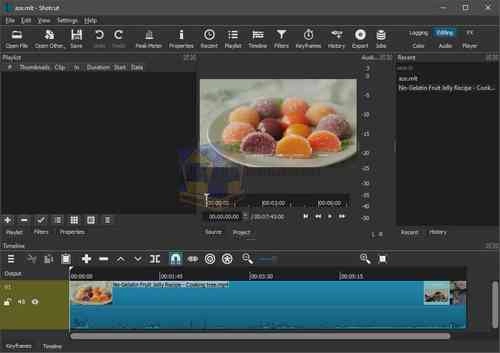Shotcut is a free, open-source, cross-platform video editing software that allows users to edit and manipulate audio and video files. Shotcut is available for Windows, macOS, and Linux, making it suitable for a wide range of users regardless of their operating system preferences...
Here are key features of Shotcut include:
Intuitive User Interface:
Shotcut provides a familiar, timeline-based interface that allows users to easily arrange and edit video and audio clips. The user-friendly layout makes it accessible to beginners and those new to video editing.
Wide Format Support:
One of the strengths of Shotcut is its ability to handle an extensive range of audio, video, and image formats. This versatility ensures that users can import media files captured from various sources without the need for additional conversion.
Video and Audio Editing:
Shotcut offers basic to intermediate video editing tools, including cutting, trimming, splitting, and joining video clips. Users can also perform audio editing tasks such as adjusting volume, adding audio tracks, and removing background noise.
Filters and Effects:
The software comes with a selection of video and audio filters that users can apply to enhance their footage. Some of the filters include color grading, blur, sharpen, and more. Additionally, Shotcut supports LUTs (Look-Up Tables) for more advanced color adjustments.
Transitions and Keyframes:
Shotcut allows users to add transitions between video clips for smooth scene changes. It also supports keyframes, enabling users to create animation-like effects, such as panning and zooming, within their videos.
Webcam and Screen Capture:
Users can record video directly from their webcams or capture their computer screens, making it convenient for creating tutorials, vlogs, or presentations.
Native Timeline Editing:
Shotcut employs a "native" timeline editing approach, which means it doesn't require a separate import or rendering process for most media formats. This streamlines the editing workflow and saves time.
Multi-Track Editing:
The software supports working with multiple video and audio tracks on the timeline, allowing users to overlay and synchronize different elements to create complex compositions.
Audio Spectrum Visualization:
Shotcut includes an audio visualization filter that generates a waveform or frequency spectrum display based on the audio in the video.
Hardware Support:
The software leverages hardware support for certain encoding and decoding tasks, potentially improving the performance and efficiency of video editing on capable systems.
While Shotcut offers powerful editing capabilities, it may not be as feature-rich or polished as some commercial video editing software. Nonetheless, it remains a popular choice for those seeking a free and reliable video editing solution.
Let's take a look at some of the pros of using Shotcut:
Free and Open Source:
Shotcut is completely free to use, which makes it an attractive option for budget-conscious users. Being open source means that the software's code is accessible to anyone, fostering community-driven development and potential improvements.
Cross-platform Compatibility:
Shotcut is available on multiple operating systems, including Windows, macOS, and Linux, making it accessible to a wide range of users.
Intuitive User Interface:
The interface is relatively straightforward and user-friendly, making it suitable for beginners. It provides a familiar timeline-based video editing layout.
Wide Format Support:
Shotcut supports a vast array of audio, video, and image formats, making it versatile when it comes to importing media files.
Frequent Updates:
As an open-source project, Shotcut receives regular updates, bug fixes, and feature enhancements. This ensures that the software remains relevant and up-to-date with the latest technologies.
Flexible Editing Tools:
It offers various editing features, including cutting, trimming, transitions, filters, and effects, providing users with a decent set of tools to work with.
Shotcut is a powerful and accessible video editing solution suitable for casual users, beginners, and those on a tight budget. It caters to a broad audience with its cross-platform compatibility and extensive format support. While it may not match the capabilities of high-end commercial software, it offers a robust set of features for basic to intermediate video editing needs. Whether you are editing home videos, creating online content, or working on small projects, Shotcut provides a viable and cost-effective option for video editing.
Shotcut - Changelog.
Install version:
Size:115.44 MB - Download
Portable version:
Size: 151.34 MB - Download
How to use Shotcut:
Shotcut is a free and open-source cross-platform video editor that can be used on Windows, Mac, and Linux. It is a powerful tool that can be used to create professional-looking videos.
Here are some basic steps on how to use Shotcut:
1. Import your media files:
- You can import video files, audio files, and images into Shotcut. To do this, simply drag and drop the files onto the timeline.
2. Edit your clips:
- Once your media files are on the timeline, you can edit them in a number of ways. For example, you can trim clips, split clips, and add transitions.
3. Add effects:
- Shotcut has a wide variety of effects that you can add to your videos. These effects can be used to enhance the look and feel of your videos.
4. Export your video:
- Once you are happy with your video, you can export it to a file format that can be shared with others.
Here are some more specific tips for using Shotcut:
1. Use the Source panel to preview your clips:
- The Source panel is located on the left side of the screen. You can use it to preview your clips before you add them to the timeline.
2. Use the Timeline panel to arrange your clips:
- The Timeline panel is located at the bottom of the screen. You can use it to arrange your clips in the order that you want them to appear in your video.
3. Use the Filters panel to add effects:
- The Filters panel is located on the right side of the screen. You can use it to add effects to your clips.
4. Use the Export panel to export your video:
- The Export panel is located at the bottom of the screen. You can use it to export your video to a file format that can be shared with others.
Shotcut is a powerful video editor that can be used to create professional-looking videos. With a little practice, you can learn how to use Shotcut to create your own amazing videos.

